Kandinsky: The Path to Abstraction
Tate Modern, London. 22 June-1 October 2006 (ED)
There are many ways of approaching Wassily Kandinsky's
work: enjoyment of his vibrant colour use, appreciation
of the often intricate designs and forms on his painted
surfaces or the realisation that his images aim at expressing
a wider spirituality with the artist seeking to mark his
place within a greater cosmological frame. The last of
these approaches is daunting enough for any visitor to
this exhibition to grasp, but whichever approach the visitor
takes there should also be an acknowledgement that Kandinsky
is one of the greatest composers of music in a visual
medium.
That Kandinsky can be thought of as a composer without
having written a single musical note is something of a
paradox, yet it is not one that Kandinsky himself might
have overly worried about and, I suggest, neither should
we. He viewed music as “the ultimate teacher”
in all the arts. The line of composers who have drawn
their inspiration from the visual arts is a long one,
as is also the case vice versa. Kandinsky though remains
a special case, being one of the few artists to think
of colour and geometric form in musical terminology, which
he eloquently expressed in a series of seminal texts.
Born in Moscow in 1866, Wassily Kandinsky's decision to
paint was largely formed in 1896 following two important
encounters: seeing one of Monet's "Haystack"
paintings, which made him realise the importance of colour
within form, and hearing Wagner's "Lohengrin".
His ‘Reminiscences’ (1913) record that: "The
violins, the deep tone of the basses, and especially the
wind instruments at that time embodied for me all the
power of that pre-nocturnal hour. I saw before me all
my colours in my mind; they stood before my eyes. Wild
almost crazy lines were sketched in front of me."
Works such as "Song - 'Chant de la Volga'" (1906)
or one of his Munich-based works, a painting of the famous
Ludwigskirche (1908) bear reference to his growing interest
in the musicality of painting through the use and distribution
of colour-as-notes, often in brilliant jewel-like sequences,
to suggest differing 'voices' at work - possessing warmth,
coolness or an inherent dynamic range when seen against
one another.
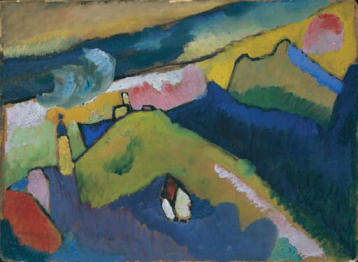
Murnau - Mountain Landscape with Church (1910)
These works reflect in part his Russian roots. A noticeable
shift occurred with the many scenes he painted from 1909
of the Bavarian town Murnau, a favourite destination with
his painter wife Gabriele Münter. He remains firmly
allied to representing the concrete and recognisable,
but his painting technique developed to express the wider
ideas that concerned him. Colour, though always integral
to form, was becoming representative of a greater yearning
of the aspirations of man. Pictorial elements such as
the vaulting rider on horseback (representing yearning)
recur throughout his oeuvre of this period.
Many of the works we have from 1910-1911 are studies for
larger works that did not survive the allied bombing of
the world wars, yet these studies are often remarkably
complete in terms of both colour and composition, beginning
to indicate a personal belief and sense of place within
a wider spiritual cosmos that carries some potency about
it. Few of his large-scale canvases express this as clearly
as "The Last Judgement" (1910). That at around
this time he also produced the Tate Gallery's "Cossacks",
which he recorded proudly as "the first modern abstract
painting in a London collection" and the image of
a horse entitled "Lyrically", depicting the
rhythm and flow of movement, shows the holding of several
disparate concerns in close proximity: the fruit of a
man with many layers to his being.
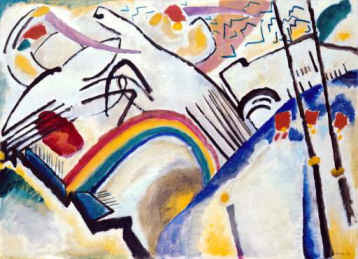
Cossacks (1910–1911)
With works from 1910-1911 showing use of colour at its
brightest, and some might say most optimistic, it is not
hard to substantiate how Kandinsky came to see his things
in musical terms, "Pink, lilac, yellow, white, blue
pistachio green, flame red houses - each an independent
song [...] the deeper tremolo of the trees, the singing
snow with its thousand voices, the allegretto of the bare
branches" (1913). Again he was to comment that "vermillion
has a sound like a tuba and a parallel can be drawn with
a loud drum beat." Such parallels were to be explored
in greater depth within the Blaue Reiter Almanac (published
1912), which he edited along with Franz Marc.
The watercolour, gouache and ink study (1911) for his
cover to the Blaue Reiter Almanac positively pulsates
density of tone - both visual and musical to the extent
that one might almost hear it too. That the background
is of the deepest blue is significant, as Kandinsky associated
the colour with the sound of the cello, an instrument
he played. A central feature of the Almanac is a simultaneous
exploration of form and meaning within the visual and
musical arts cannot be escaped.
Few of the Almanac's contributors were as fluent in the
visual and musical arts as Arnold Schoenberg. Whilst his
music broke new ground in terms of technique, in the same
respect his paintings seem a little awkward. Subject matter
held sway with inward looking expressionist visions of
troubled souls, particularly the painter’s own,
very much in contrast to Kandinsky who steered clear of
the self-portrait genre. The world-view represented by
Schoenberg’s paintings cannot easily be separated
from that in Mahler's music - whose funeral Schoenberg
captured with naively in hastily brushed oils on card.
Wider knowledge of both composers can lend another dimension
to viewing Kandinsky’s works as they can be both
aligned to and pitted against the represented aesthetics.
1911 also saw the publication of Kandinsky's treatise
"On the Spiritual in Art" and with it a growing
interest in the categorisations of his works into Impressions,
Improvisations and Compositions - terms he was to continue
using with some frequency and specificity of purpose.
His text would articulate his passionate belief that works
must arise out of an internal necessity within the artist.
The small room containing drawings from c.1911 emphasises
the angularity of his line and sparseness of texture in
forming his compositions. One included in the exhibition
even bears marks that look uncannily like a musical stave
- though devoid of any other overt musical references.
A later painting on Glass (rarely exhibited due to the
fragility of the support) shows both the influence of
Russian painting style and a fine assimilation of naive
Bavarian painting fused into one. A single image to perfectly
capture one aspect of the Blaue Reiter aesthetic.
I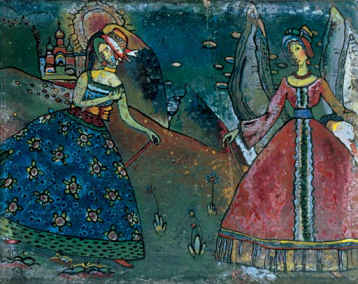
Two Girls – painting on glass (1910–1911)
1913 and the years of World War I reflected
another change of mood and tone, picking up on the destruction
around him. Increasingly a darkened palette is used, giving
the apparent air of disillusionment with man's predicament
to the works. That figuration is foregone also reinforces
the impression in several large-scale works, such as "Composition
VII" (1913) where painterly gestures form entangled
webs of patterns overlaid on each other. "Painting
is like a thundering collision of different worlds...
technically every work comes into being as the cosmos
by means of catastrophes, creating the cacophony of the
various instruments of that symphony we call the music
of the spheres. The creation of the work of art is the
creation of the world." The words might almost have
been spoken by Mahler.
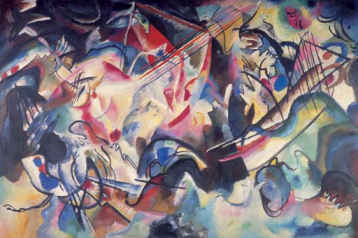
Composition VI (1913)
"Fugue" (1914) most overtly brings to mind musical
form its visual and musical parallels, and this is something
Kandinsky very much intended, with colours taking on the
role of instruments whose lines weave into one another
and around to disappear and reappear: structure within
apparently fluid confines. The years 1917-1919 saw a thinning
out of forms in his work and subdued palette coming to
the fore – greys, blacks. If there is a certain
accompanying sparseness to his compositions too in them
one can detect the influence of Malevich and Rodcheko
in their treatment of pictorial space. Austerity though
for Kandinsky did not require the abandonment of richness
in the application of paint as it did with the others,
and for this he was branded a bourgeois artist in Russia.
The act of painting and the role he played as a painter
still very much mattered to him personally.
The final years charted by this exhibition, 1920-1921,
saw the attainment in his work of what many would understand
as pure abstraction: “Form itself, even if completely
abstract resembling a geometric form, has its own inner
sound, its harmony.” Works such as “White
Centre” (1921) display this with the dramatic inclusion
of dark diagonals that might be read as waves or resonances
out of which nature and a wider cosmology, represented
by yellow triangles, seemingly appear.
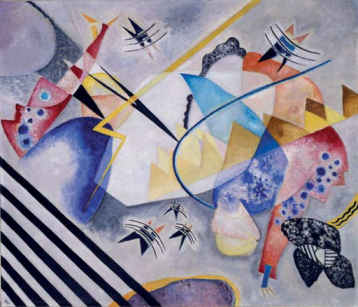
Caption: White Centre (1921)
That I feel the exhibition concludes on something of a
held chord when you can sense a passage of consolidation
still to come is quite understandable. 1922 saw Kandinsky
move to Berlin and the taking up of a post at the Bauhaus,
where he taught until the Nazi’s forcibly closed
the school in 1933. The final ten years of his life were
spent in Paris in an atmosphere of some isolation; his
work, which expounded and revisited its main themes with
dogged obssessiveness, was increasingly felt to be out
of tune with what became the avant-garde. As a unifying
artistic force though, Kandinsky remains one of the most
indelible of the twentieth century and his work is testament
to that.
This is an exhibition that is intensely rewarding and
endlessly resonating. Visit it with open eyes and equally
open ears.
Evan Dickerson
Image credits:
Murnau - Mountain Landscape with Church (1910)
oil on cardboard 327 x 448 mm Städtische Galerie
im Lenbachhaus, Munich
Cossacks (1910–1911) oil on canvas
946 x 1302 mm
frame: 1118 x 1477 x 74 mm Tate Gallery, London; Presented
by Mrs Hazel McKinley 1938
Two Girls (1917) painting on glass 200 x
245 mm
frame: 265 x 310 x 35 mm Private Collection, London
Composition VI (1913) oil on canvas 1950
x 3000 mm
State Hermitage, Saint Petersburg, 2006
White Centre (1921) oil on canvas 1187 x
1365 mm
Solomon R. Guggenheim Museum, New York Hilla Rebay
Collection, 1971
All images obtained from the Tate Gallery website that
accompanies the exhibition.







